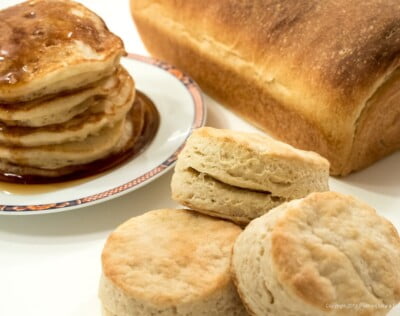 Buttermilk is what we call a “rounder” in food service. It is a person, or in this case an ingredient, that can do almost everything. Buttermilk makes unbelievably tender pancakes, the flakiest biscuits, superior bread, and extraordinarily moist cakes. It can do all of this because of the presence of lactic acid.
Buttermilk is what we call a “rounder” in food service. It is a person, or in this case an ingredient, that can do almost everything. Buttermilk makes unbelievably tender pancakes, the flakiest biscuits, superior bread, and extraordinarily moist cakes. It can do all of this because of the presence of lactic acid.
How Buttermilk is Made
While buttermilk was originally the milky liquid left from churning cream into butter. Today it is made using low fat or skim milk to which active cultures are added and heated. The cultures convert some of the sugar in the milk into lactic acid. Because of this acid, the milk proteins are not as soluble and cause clabbering or thickening of the milk. The lactic acid also causes tartness in the buttermilk.
Buttermilk also increases the leavening of baked goods. However, it is important to remember that because buttermilk is acidic and that baking soda is needed to produce carbon dioxide gas leading to increased lightness in products made with buttermilk.
Types of Buttermilk
While liquid buttermilk can be found in the dairy section of a grocery store, there is also a dried buttermilk powder. While it can’t be reconstituted into liquid buttermilk it works well for baking. I use is it in my Croissant recipe, which a Frenchman once proclaimed it the best he had ever eaten.
When using buttermilk, always shake it before pouring it out as the milk solids usually sink to the bottom of the carton. It lasts a very long time, up to a month, in the refrigerator.
Substitutions for Buttermilk in Baking
While none of these match the taste of pure buttermilk, these substitutes can work when baking to a more or less degree. However, if making ranch dressing for marinating chicken, you need to use the real thing.
- Combine 1 tablespoon of vinegar or lemon juice to a cup of whole or low-fat milk. Let sit for up to 10 minutes when it will separate and thicken. The acid in the lemon juice or vinegar emulate the cultures used to make buttermilk. In reality, this is “sour milk”.
- Plain yogurt can be used. To make one cup, combine ¼ cup milk or water with ¾ cup plain, non-sweetened yogurt.
- Because the cream of tartar is an acid, whisk 1 ¾ teaspoon cream of tartar into 1 cup of milk.
I am including several recipes using buttermilk. Each of these is made better with buttermilk.
Buttermilk Bread
I have made this bread for over 40 years since my son brought it home when he was in the third grade. While the paper on which the original recipe was written, I still have it with Dirk’s notes on it. It is my favorite everyday bread. After the dough is made and risen once, it can be frozen unbaked. Thaw in the refrigerator overnight and proceed as instructed.
3 tablespoons butter, melted
½ cup buttermilk
1 ½ tablespoons sugar
1 ½ teaspoons active dry yeast
½ cup hot water
2 ½ cups bread flour (350 grams, 12 ounces)
1 ¼ teaspoon salt
¼ teaspoon baking soda
Whisk together the melted butter, buttermilk, sugar, and yeast in a mixing bowl. Add the hot water and let rest for about 5 minutes. Fit the mixer with a dough hook if you have one.
In the meantime, combine the flour, salt, and baking soda.
Add the dry ingredients and beat on low to combine everything, then turn to medium or whatever your mixer suggests and beat for 3 minutes. Spray a large container with cooking spray and turn the dough into it. Cover with plastic wrap. Set in a warm place and allow to rise for about 1 ½ hours or until doubled in bulk. At this point, it can be frozen if desired.
Spray an 8x4 ½ inch loaf pan with cooking spray. Punch dough down and pat into an 8”x13” rectangle. Roll up from the 8” side and place in the loaf pan. Flatten somewhat Let rise for about 45 minutes until doubled.
Preheat the oven to 375 degrees (350 degrees if the pan is glass or dark metal). Bake for 30 to 35 minutes until nicely browned and it sounds hollow when thumped.
Fluffiest Pancakes
These are truly the lightest and best pancakes I have ever made. I doubt I will ever make anything but these again. So that Mike and I can eat together, I cover a baking pan with foil and place the cooked pancake cakes on it. I cover the pan lightly with foil and place them in the oven set on the lowest heat where they will stay hot.
1 ½ cups all purpose flour (210 grams or 7 ⅓ ounces)
2 tablespoons sugar (25 grams or 1 scant ounce)
1 ½ teaspoon baking powder
½ teaspoon baking soda
½ teaspoon salt
1 ¾ cup buttermilk
1 egg
2 tablespoons vegetable oil
1 teaspoon vanilla
Whisk the dry ingredients in a medium-size bowl.
Measure the buttermilk in at least a 2 cup container. Whisk in the egg, vegetable oil and vanilla.
Pour into the dry ingredients and whisk together.
Heat a skillet or griddle over medium heat. To see if it is hot enough, sprinkle a few drops of water on it. If it dances around the pan or griddle and then evaporates, it is ready.
Add a bit of butter or spray the pan. Ladle about scant ¼ cup batter for each pancake, spreading it gently into a 4-inch circle.
Flip the pancake when bubbles appear on top and the edges look dry. Cook another couple of minutes until lightly browned in brown in the center.
Serve with syrup, fresh fruit, fruit sauce or simply dusted with powdered sugar.
Makes about 12 pancakes. If we have leftovers, I freeze them. I place them on a foil covered baking sheet, cover them with foil and put them in a 350°F oven for 12 to 15 minutes or until piping hot.
Some buttermilk recipes you are sure to enjoy include: Cinnamon Filled Buttermilk Scones, Buttermilk Flatbreads, Crunchy Topped Apple Muffins, and Traditional Irish Soda Bread.


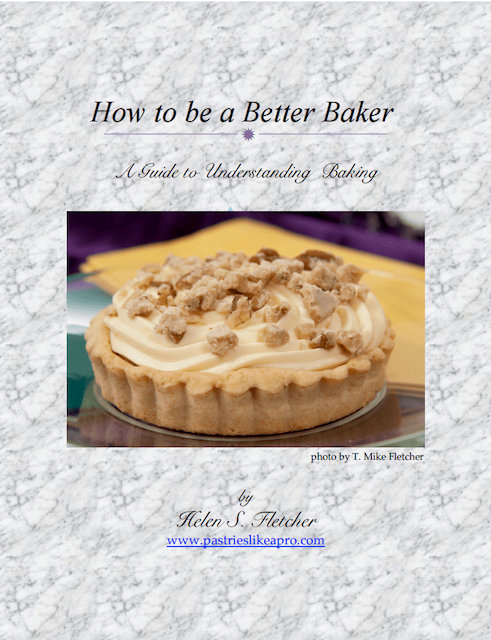
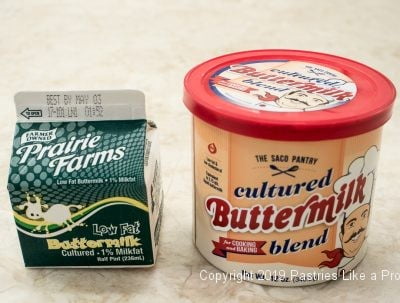
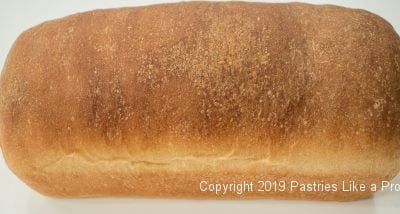
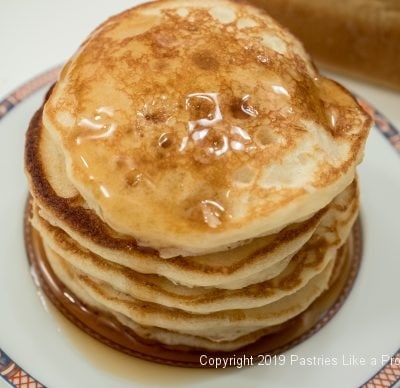

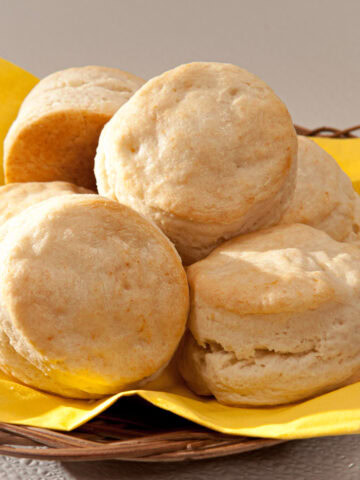
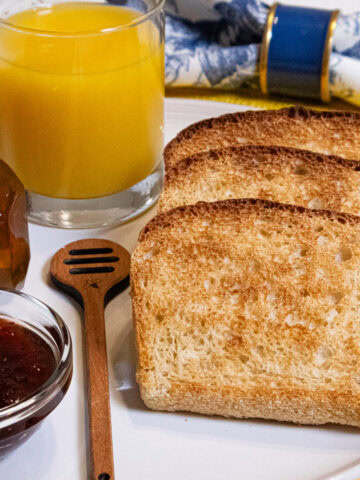

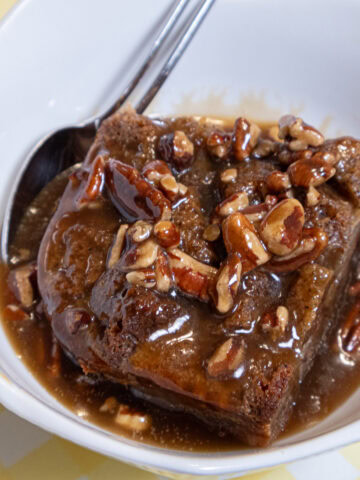
Bill says
Your link to the buttermilk biscuits doesn't work. I would like to see the recipe.
Helen S Fletcher says
Hi Bill, I have tried every iteration of "Grandma's Flaky buttermilk biscuits" I can think of including Cooking Maniac from whose blog it comes and it doesn't come up so I unlinked it. Have a go at it and see if you can get it to come up. That is an old blog, still viable, but in the meantime the blog may not be online anymore. The stange thing is I didn't get a 404 or any thing else to tell me it no longer exists.
J Hertsgaard says
Does the dough get punched down before freezing or frozen in the "doubled size?" Thank you for your time, and what looks like a very good bread recipe. My apologies if I missed the answer in the article/recipe.
Helen S Fletcher says
I don't think it matters. But in the next paragraph, it tells you to punch the dough down after rising, so I would deflate it before freezing. Then allow it to defrost in the refrigerator before shaping it. Or it can be shaped and then frozen if desired. Thaw and allow to rise in the pan then bake.
J Hertsgaard says
Thank you so much for the reply...I figured I likely missed it and thought I had done a better job of looking. Anxious to try this recipe.
Helen S Fletcher says
You did just fine. I'm happy you're going to make this bread. It is my favorite go to white bread.
JudyW says
I noticed the amount of yeast is 1 1/2 teaspoons. Is that the correct amount or should it be 2 1/4 teaspoons. I've never made bread where it calls for the smaller amount. Thank you.
hfletcher says
Hi Judy, the 1 1/2 teaspoons yeast is correct. The recipe was cut down from a 2 loaf version that used 1 package (2 1/4 teaspoons) of yeast.
Lynne Cameron says
Have you ever tried kefir in place of buttermilk? I always have kefir but would need to look for buttermilk, which I know is always in the supermarket, but why not use what I have? Thanks
hfletcher says
I have never tried it because I always have buttermilk but don't have kefir. No idea if it would or not.
CNNY says
Thanks for the post. I'm a big fan of buttermilk in baking, it creates a wonderful texture in cakes. For your bread recipe - what is the purpose of the baking soda? Is it for browning? Thanks.
hfletcher says
I have no idea why baking soda is there. There would be no reason the bread wouldn't brown without it. This is how the recipe came to me so I just follow it.
Lynette Pruett says
Another comment I have is about your pancake recipe. I’ve been making pancakes from this basic recipe since my aunt gave it to me soon after I was married in 1970. Gee...can it have been that long!?! At first I made the pancakes with all-purpose flour, but by 1972 I was transitioning to using almost exclusively whole wheat flour, and I’ve found that the pancakes made with this recipe are just as light and fluffy when made with whole grain flour as when made with all-purpose. Sometimes I do need to use a bit more buttermilk, depending on how humid the air is in different seasons and therefore how relatively "wet" or "dry" the flour is. One other tip that I find useful in making pancakes: I use my #20 Vollrath disher to dip and deposit the batter on my griddle. It’s quick and easy, and all of the pancakes come out the same size! Our family loves these pancakes! And I agree that there is no reason to use any other pancake recipe...it’s hard to improve on perfection!
I make a lot of yeast bread, and I think I will try making your Buttermilk Bread with whole wheat to see what the results are. Have you ever made it with whole grain flour?
hfletcher says
Hi Lynette, thanks for your comments. I have made the bread in the past with whole wheat - either the white or regular works fine. I use a ladle for sauces on ice cream sundaes from my father's drugstore. Any consistent measure, even a 1/4 to 1/3 cup measuring cup works well. I think you are right about the cardboard being porous. Good tip.
Bruce says
I agree with Lynette. I wish the dried buttermilk came in a smaller container, though, because it clumps very badly after a while, making it hard to work with.
hfletcher says
Hi Bruce - I never had that problem but I didn't refrigerate mine. Do you? You could probably push it through a strainer or process it. Maybe process it, lay it out flat on a parchment covered sheet pan, freeze it and store it that way. Just a guess. I haven't tried it.
Karen Aamodt says
Hi Helen,
Thank you for a wonderful post; I will bake Dirk's 3rd grade bread recipe this weekend. I'm sur eit will be wonderful if you've been baking it for 40 years.
Karen
hfletcher says
Hi Karen - You're going to love it. It lasts for days in a plastic bag but we eat it too fast to see just how long it lasts!!
Lucie C Conner says
I live in the Country of Panama and I bring back from the States the Dried Buttermilk. In your recipes above, how would I use this buttermilk, do I use as is and increase liquid, or make it up per the package and then follow your recipe?
I love your baking and tips, thank you.
hfletcher says
Hi Lucie - I have not used dried buttermilk in a recipe calling for buttermilk. It won't be as thick and it may change the recipe. My suggestion is to use one of the three substitutes as they all have the requisite thickness.
Lynette Pruett says
Helen, I keep dried buttermilk powder in my pantry all the time, for the rare occasions when I don’t have fresh in the fridge. I have found that if you measure and mix the dry powder as required for the liquid ingredient in the recipe with the other dry ingredients, and then mix the amount of water with the other liquid ingredients in the recipe, when you combine dry with liquid you get a very good approximation of using fresh buttermilk. It doesn’t work so well that I never bother to keep fresh on hand, but it certainly is a very acceptable substitute. I’ve been very pleased!
hfletcher says
Thanks for the info Lynette - do you keep yours in the fridge or on the pantry shelf? I read it should be refrigerated after opening but I never did. It is nice to have on hand though. I agree about dry to dry and wet to wet. That's what I did with the croissant.
Lynette Pruett says
I do keep mine in the refrigerator, and I’ve never had it get hard clumps. I actually transfer it from the can, which is made of a porous cardboard material and seems to me to have the possibility of absorbing moisture, to an OXO POP container, which are airtight and don’t absorb any moisture whatsoever. So that’s my method, and it works for me!